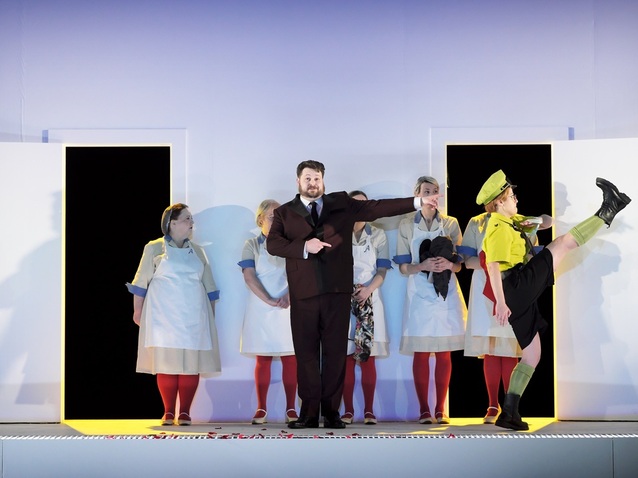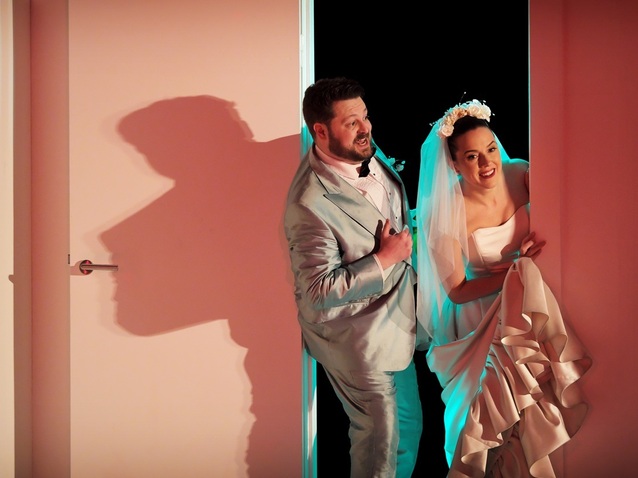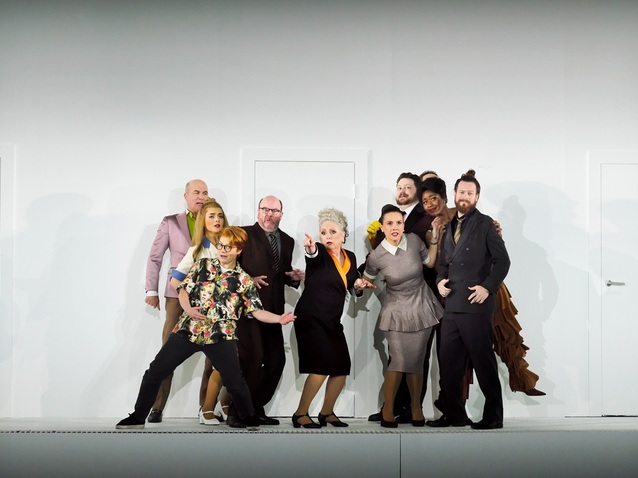 © ENO / Zoe Martin
© ENO / Zoe Martin
In 2020 director Joe Hill-Gibbins did not have much luck with his new staging of Mozart’s The Marriage of Figaro for English National Opera. Premiering on 14 March of that year, it was set to run until 20 April, but enjoyed no more than its first performance after COVID-19 saw all UK theatres close the following week and a formal lockdown declared on 23 March. What is technically therefore the production’s first revival at the Coliseum is in reality the first time it will enjoy a full run of performances there.
The Marriage of Figaro of 1786 is one of three operas on which Mozart collaborated with the librettist Lorenzo Da Ponte (the others being Don Giovanni and Così fan tutte). It is based on the second of Pierre-Augustin Caron de Beaurmarchais’ trilogy of Figaro plays, while the first was later to be immortalised by Rossini in The Barber of Seville. It centres on the day on which Figaro, valet to Count Almaviva, tries to wed Susanna, maid to his wife the Countess. The womanising Count is intending to restore the droit du seigneur, an abolished feudal law that allows a lord to enjoy any female servant first on her wedding night, because he craves Susanna. Figaro and Susanna thus set out to outwit him as a youth named Cherubino causes havoc with his own promiscuous ways, the Countess feels completely unloved and neglected by the Count and an ageing woman named Marcellina insists that Figaro marry her unless he can pay off his debt. It does have a happy ending, notwithstanding the fact it seems doubtful the Count really will change his ways, and it remains one of the most frequently performed operas in the world today.

David Ireland, Hanna Hipp, ENO’s The Marriage of Figaro 2025 © Zoe Martin
Hill-Gibbons’ staging, which represents a co-production between ENO and Oper Wuppertal, sets the action broadly in the modern day, but the specific time period is of less importance than the dynamic. Johannes Schütz’ set consists of a white box-like room that stands (for the most part) at the front of the stage, and has four doors in its back wall. The Overture features a complex routine that sets the tone for the evening by seeing principals and chorus members continuously pop on and off the stage through the various doors. The skill with which it is choreographed by Jenny Ogilvie, so we gain a keen sense of who is trying to be alone with (or conversely avoid) whom, is immense as every so often the servants stream across the stage and disrupt whatever intimate moments might have been developing between characters.
The room proves to be very flexible so that at the start it represents Figaro and Susanna’s prospective bedroom. As the pair open the doors to reveal how close the Count and Countess’ own chambers are, these figures are actually shown emerging from them. Of course, they would not really be there but this production deliberately blurs the line between representation and reality. Similarly, when Figaro addresses the Count in his mind in Act I’s ‘Se vuol ballare, Signor Contino’, here his master is actually present and dressing in all his finery.
The set does have a few limitations. In the Act I scene in which both Cherubino and the Count end up hiding, they hide behind the opened doors. This seems nonsensical since they could just as easily, and far more securely, hide behind them when closed, and yet if they did so they would be completely out of sight and there would be no humour in the situation. It also forces the production to ignore the whole point that the Count unwittingly hides in the place where Cherubino already is, forcing the latter to move.
The set rises for Act II, and if at first it seems lame for the same space to be used again the success of this decision soon becomes clear as the basic set-up is then embellished with a host of details that really bring the scene to life. Chief among them is a staircase that we see leading up to one of the four doors. This is the means whereby anyone can enter or exit the room, which prompts some strong coordination to ensure that everyone is in the right place at the right time to ascend or descend it. When it is pulled away we also have a strong visual reminder that those inside the room are trapped. Act IV, which takes place in a garden, is also well executed as the set is pushed to the back and the spacing of the characters across the fore, middle and background helps to highlight all of the intriguing encounters that take place in the dark.

David Ireland, Mary Bevan, ENO’s The Marriage of Figaro 2025 © Zoe Martin
One might argue that the dynamic generated by this production exists for its own sake, as its primary aim is simply to entertain, but this is a staging that can be taken on many different levels. When the Count sings ‘Vedrò, mentr’io sospiro’ he opens the four doors to reveal all of the characters in various compromising positions with each other. This might reveal something about the Count’s own depraved mind, but it could also be a commentary on free love. Throughout the evening there are moments, such as during the Act I scene between Susanna, Cherubino, Don Basilio and the Count, in which characters who are at loggerheads suddenly engage in routines that see them become more amorous. Looked at this way, the staging could be providing a commentary on the subject of free love arising out of choice versus the old, brutish, non-consenting ways of the Count. Since it seems all of the other characters subscribe to the new philosophy, this would explain why the Count is left all alone at the end here.
The few missteps along the way generally derive from trying to impose a more dynamic tone onto moments when the tenderness that the music suggests needs to come across free from distraction. To have Cherubino jiving as he sings ‘Voi che sapete che cosa è amor’ totally ruins the point that this is one moment that reveals his more heartfelt and sensitive side. Similarly, the sharp poses adopted by the chorus of peasants who greet the Countess suggest ‘attitude’, which seems at odds with the sweetness and purity of the music. In direct contrast, the wedding scene flows in an almost dreamlike swirl that is highly effective, and the movement across the evening is notably slick.

ENO’s The Marriage of Figaro 2025 © Zoe Martin
Hanna Hipp, who also played Cherubino here in 2020, reveals a persuasive mezzo-soprano as she suggests something akin to a modern day teenager, but all other cast members are new to this production. However, Nardus Williams was set to play the Countess for some of the performances in 2020, and has taken the same role for Opera Holland Park and Glyndebourne. She reveals an exceptionally radiant soprano and reveals a winning combination of elegance, dignity, sorrow and forgiveness. Mary Bevan also sang Susanna for ENO in 2014 in Fiona Shaw’s production, and here displays an engaging and well shaped soprano alongside some effective mannerisms. As Figaro, David Ireland offers a strong bass-baritone and some astutely observed gestures, while, with his rich and assertive baritone, Cody Quattlebaum is convincing both as the predatory Count, and the rattled figure in such arias as ‘Vedrò, mentr’io sospiro’. Hubert Francis as Don Basilio combines a certain obliviousness to the machinations of others with his own sense of mischief. Rebecca Evans and Neal Davies are luxury casting as Marcellina and Dr Bartolo, while Ava Dodd as Barbarina sings ‘L’ho perduta’ beautifully and Trevor Eliot Bowes, with his brilliantly firm bass, leaves quite an impression in the small role of Antonio. In the pit Ainārs Rubiķis explores many facets of the score, and the overall result is quite an exciting account.
By Sam Smith
The Marriage of Figaro | 5 - 22 February 2025 | London Coliseum
the 07 of February, 2025 | Print
Comments